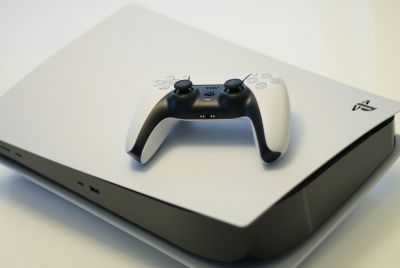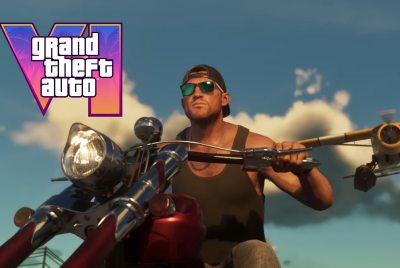Arms review: Is Nintendo's gangly Switch fighter a championship contender?
Do you even Arms, bro?
Arms
Platforms: Nintendo Switch
Developer: Nintendo
Publisher: Nintendo
Release Date: 16 June
All it takes is a quick glance at Nintendo's gargantuan back catalogue to realise that the Kyoto giant has a remarkable knack for toying with established genres. The majority of these prior experiments have been headlined by Mario and his Mushroom Kingdom pals, but Nintendo has also put this design philosophy to test with unique new heroes.
Nintendo inhabited the often militaristic strategy genre with flora and bug-life in Pikmin, made gentrified, menu-heavy city management simulators fun with the twee anthropomorphic villagers of Animal Crossing and, most recently, splashed violent shooters with glossy paint in Splatoon.
When it comes to family-friendly fisticuffs, Nintendo already has its popular Super Smash Bros franchise - a series that raised the bar for crossover brawlers and has become a mainstay of eSports competitions across the globe.
With that series yet to arrive on Switch (for the time being at least), a fresh challenger has been tasked with bringing the fine art of duffing dudes up to Nintendo's latest hardware. Enter Arms, a fighter that's a world away from the platforming free-for-all design of Smash that instead adopts the arcade ethos of classic scuffle-fest, Punch-Out.
Rather than juggling and dodge-cancelling your way past multiple opponents as in Smash's frenzied 2D bouts. Arms locks your gaze to a single slippery foe (you can switch in team battles and manic three or four-way brawls) with the third-person camera floating behind the player. Timing your left and right hooks, dodges, blocks and super moves - dubbed Flurry Attacks - is key to victory on harder difficulty levels or in the fearsome online arena, though as with any Nintendo-made fighter, button mashing is a viable alternative for trainees.
Arms ditches the comic book boxing rings, uppercuts and Glass Joes of Punch-Out and goes full cartoon crazy, slapping Stretch Armstrong-style extendable limbs on a zany roster of ninjas, silver-haired celebrities, robot policemen and green goo monsters, and shifting the action to a small but varied number of gimmick-laden arenas.
What it does take from Punch-Out - from its last entry on the Wii at least - are motion controls. Arms is the poster child for Nintendo's revival of the perennially maligned waggle-control that brought Nintendo enormous commercial success with the Wii, but also led to the console' library being swamped by awkward-to-control shovelware.
Thankfully, Arms isn't just an incredible proof of concept for the motion technology in the Switch's detachable Joy-Con controllers, it may also be the best ever example of motion controls actually used well.
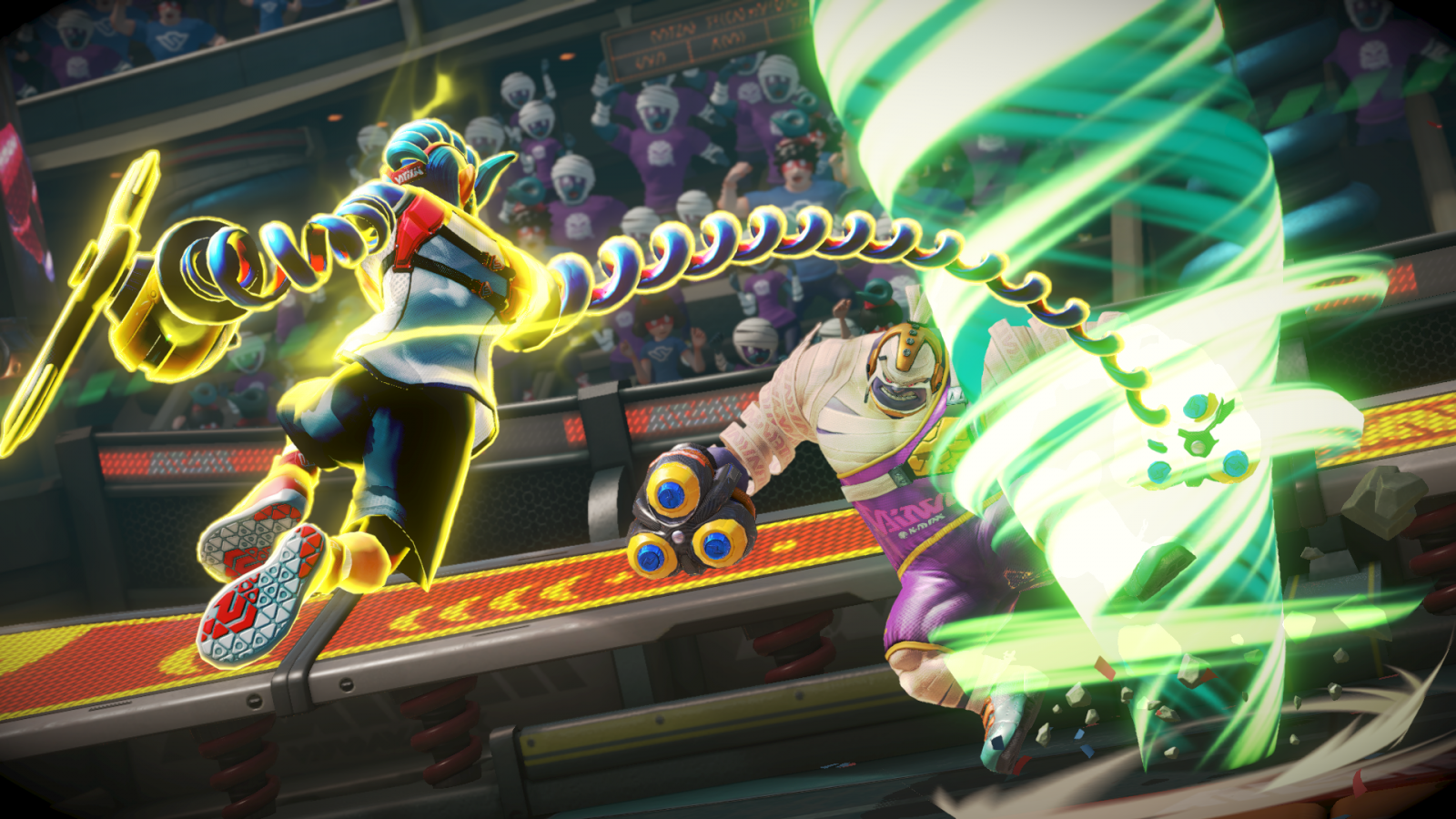

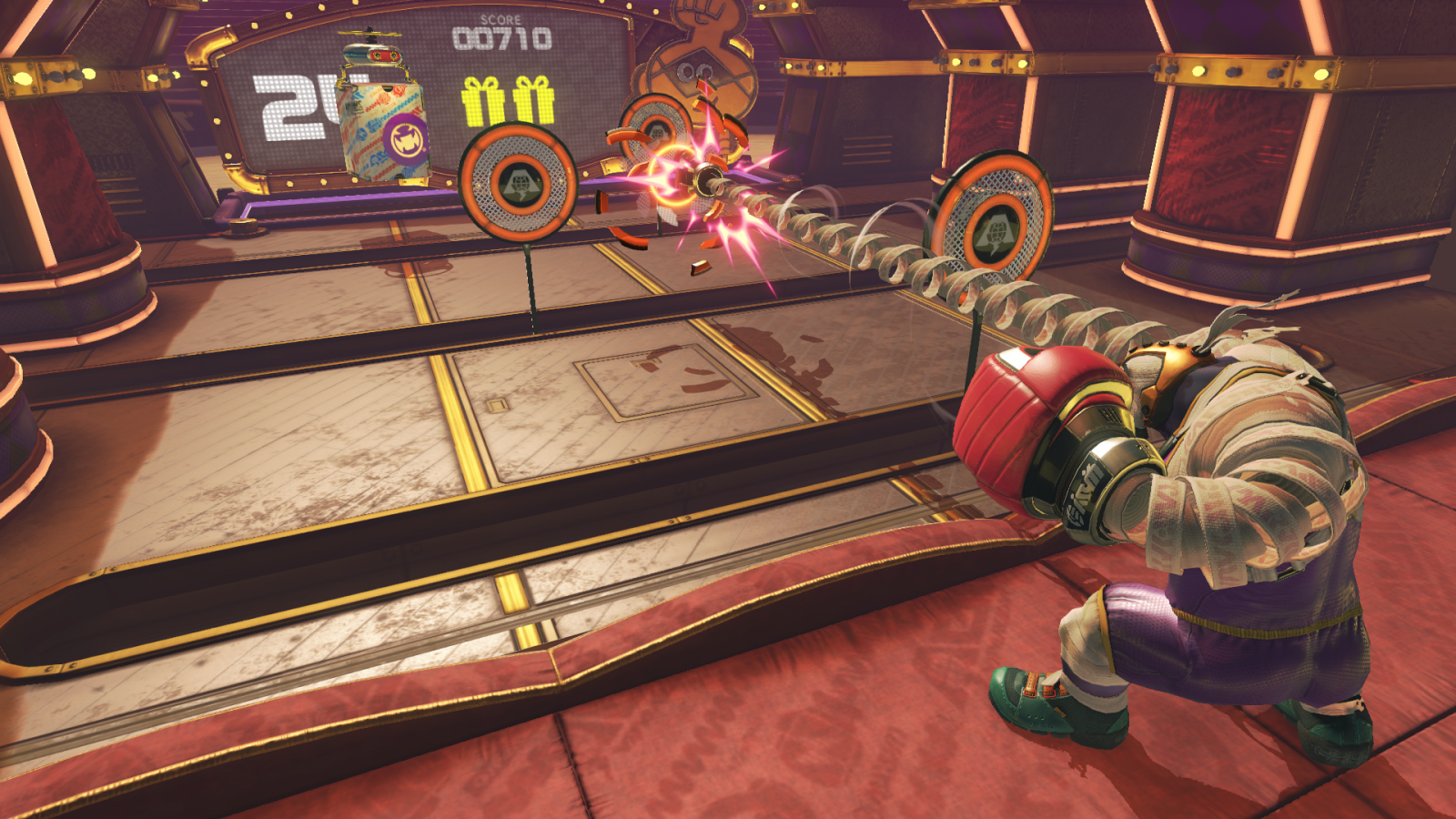
In Arms, curving a powered-up punch around an obstacle and into an opponent's smug face is devilishly satisfying, and rarely accidental. The cognitive link between the player's physical swing and your character's extending strike is spot on. Calling it 1:1 control between the player and onscreen fighter would be a mistake, as there's an imprecise weight to each jab that creates a haphazard and frantic feel. This may sound like a criticism, but its a perfect fit for the Looney Toons clashes Arms is aiming for, and is far more fun for it.
Slinging your arms around in hope of catching a cheap hit is fine for beginners, but timing a volley of punches for the moment your competitor comes out of an air-dodge takes patience and unerring timing. Its here where Arms shares most of its DNA with Little Mac's retro gauntlet, and cranking up the difficulty levels will leave all but the most practiced and dedicated Arms players with bruised cheeks.
Knowing when to counter a high-damage grab with a one-armed strike or the correct moment to unleash or dodge a Flurry Attack are just a few of the techniques that are paramount during the 10-bout Grand Prix mode's tougher stages, but taking the fight online reveals a number of mechanics that are even more vital for breaking the deadlock.
The titular "Arms" play a larger role here, with some tailored to close-quarters play and others better for a speculative arena-length jab. Mixing and matching your arsenal (armsnal?) based on your opponent's tactics is rewarding in every sense of the word, as is flitting between characters to test out their unique traits. Whether it's Spring Man's last ditch damage increase at low health, Min Min's dash kicks or Master Mummy's health regain ability, understanding each gangly warrior's strengths and weaknesses separates contenders from champions.
Combined with environmental factors like rideable spinner pads and trampolines in certain stages, the myriad variables for each bout will keep players on their toes. This intensifies with an increased player count, especially in 2v2 battles where a tether between you and your ally can be a boon for co-operative onslaughts, but also a hindrance when you are dragged to the floor by a sharp, unexpected yank.
Whether or not Arms is Nintendo's next eSport remains to be seen, but the foundations are clearly there. The effect any disparity between those who prefer the motion controls over optional gamepad support may also effect Arms' sustainability, although unlike Mario Kart and Splatoon, playing with a traditional controller almost does Arms a disservice. The support isn't terrible by any means, but it is far less gratifying to land a piercing blow by merely squeezing a trigger and with waggle Arms feels a lot more comfortable (your own achy arms aside).
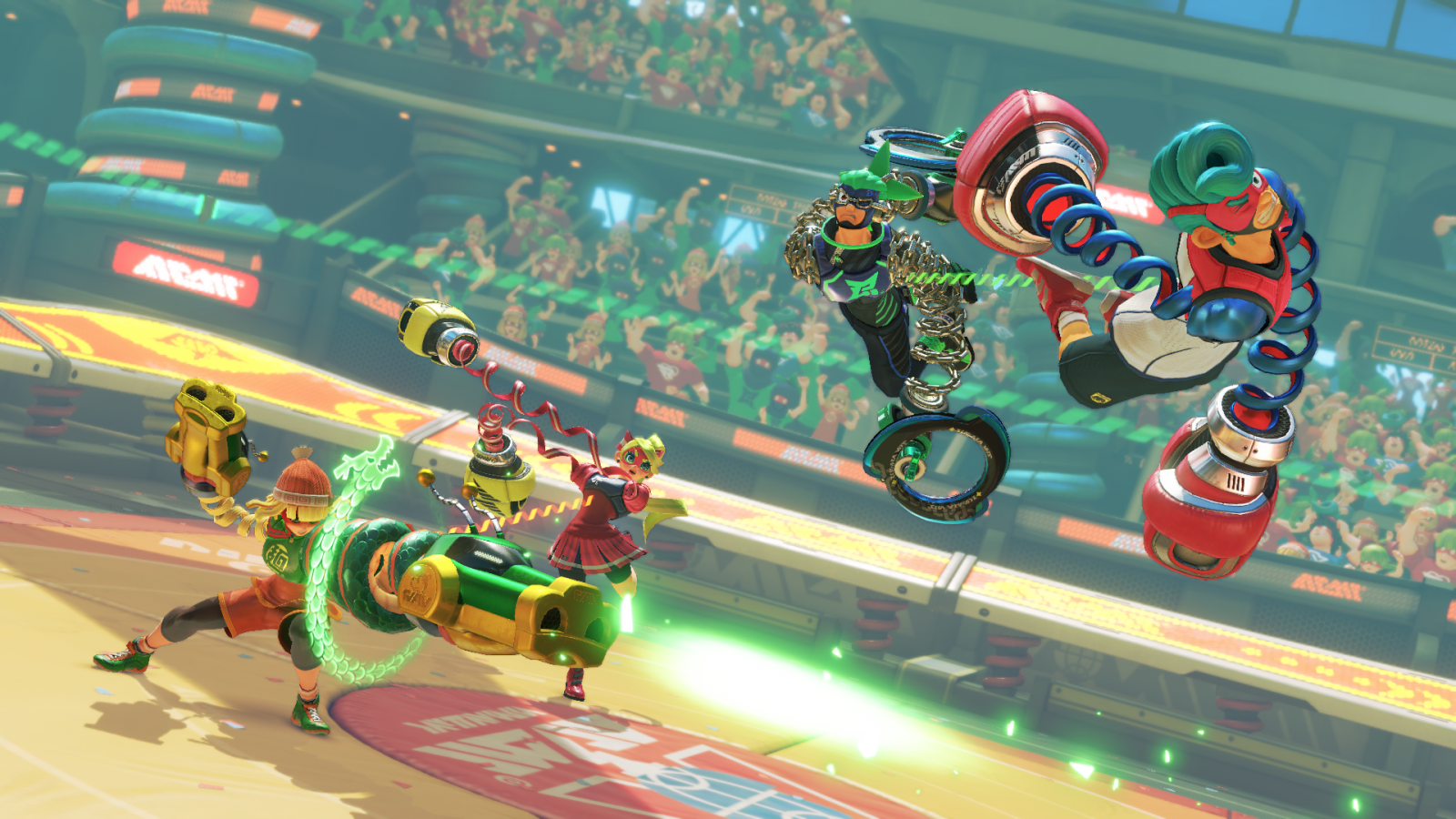

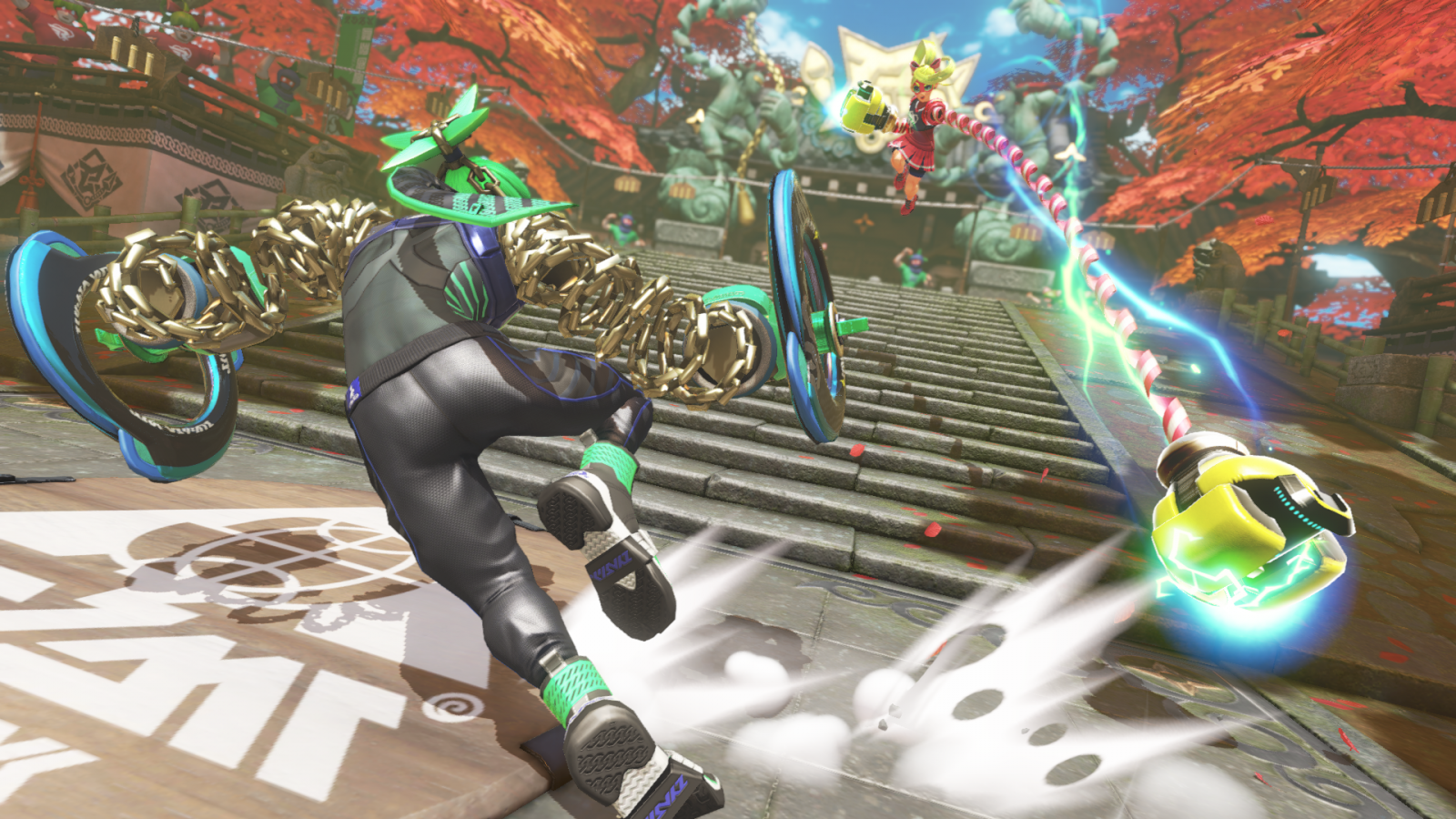
It's in its depth of modes that Arms does suffer. Within the single-player Grand Prix, as well as local and online multiplayer, there are several additional game types which waver drastically in overall quality. Hoops is easily the best of the bunch - here your goal is to grab the opposition and dunk them into a basketball net for points, a match-up the plays into the bait-and-strike gameplay Arms excels at.
Conversely, Skillshot and V-Ball rely on pinpoint accuracy and makes only a handful of arm attachments viable - two factors that actively oppose Arms' best traits. 1-on-100's self-explanatory against-the-clock brawl with AI opponents is a fleeting diversion too, but lacks substance.
A similar complaint was levelled at Nintendo's other recent day-glo genre-subversion Splatoon, but Nintendo supported the game incredibly well for months after its launch, creating a bigger and better game with each free update and solidifying it as the company's most popular new IP in years. Arms is in need of similar support, and the prospect of that happening is a cause for optimism that it will mirror Splatoon's knockout success in the long term.
The enjoyably diverse Arms roster are an honourably quirky bunch, but aside from the shrieking amorphous blob Helix and Twintelle - whose shapely figure has already struck a chord with fans online - the lack of character interaction, and occasionally derivative design, cripples their overall appeal. The most telling example of this failing is Biff, the game's diminutive match commentator, who appropriately has a fist sprouting out of his bonce. He'll natter away before each Grand Prix fight and drop a chuckle-worthy pun or two, but he's also completely forgettable. Clearly intended to be Arms' version of Splatoon's Callie and Marie, to paraphrase the squid-kid twosome, he's not quite as "fresh".
What Arms lacks in personality and content it makes up for in raw joy and a best-in-class motion control set-up that feels both comfortable and natural. Arms showcases once again that Nintendo is peerless when it comes to subverting genres without sacrificing what makes them great. Time will tell if Arms has legs to match Splatoon, but the early round scoreboards are certainly swinging in its favour.
For all the latest video game news follow us on Twitter @IBTGamesUK.
© Copyright IBTimes 2025. All rights reserved.







